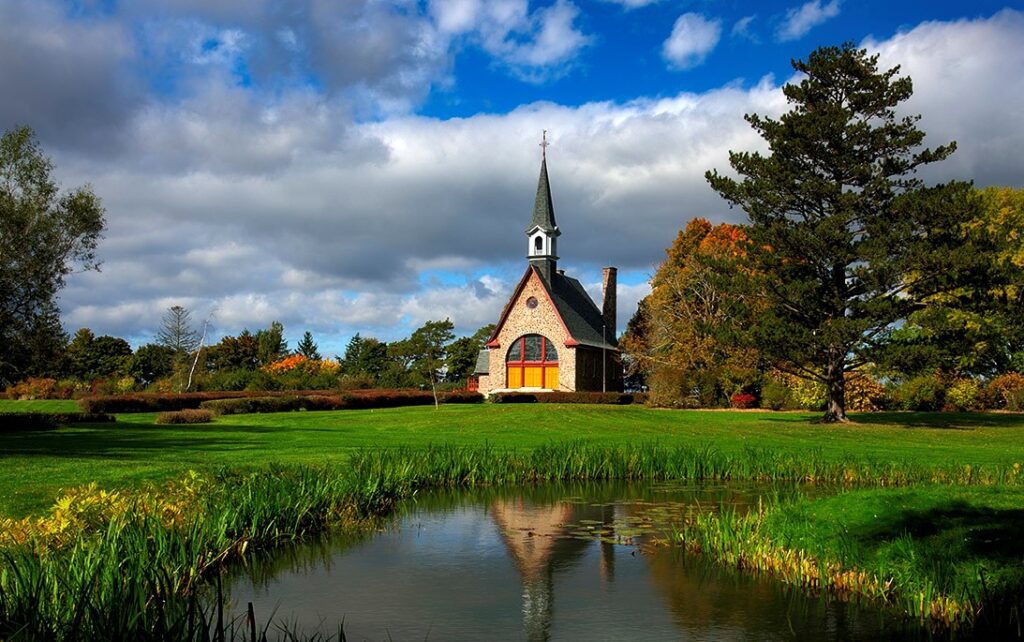The Landscape of Grand Pré
The Landscape of Grand Pré


UNESCO World Heritage Site - The Landscape of Grand Pré - Day 488 - Daily Content Challenge
The Landscape of Grand Pré is another UNESCO World Heritage Site that is located in Nova Scotia, Canada. In 2012, it became Canada’s 16th World Heritage Site, designated by UNESCO.
The Landscape of Grand Pré is located on the Bay of Fundy’s Minas Basin in Nova Scotia’s Annapolis Valley. This is part of the Mi’kmaq people’s unceded homeland.
The Landscape of Grand Pré is an historic site giving testament to the rich cultural heritage of the Acadian people who lived in this area in the 17th and 18th centuries. The Grand Pré site covers over 3,000 acres of land featuring rolling hills, lush marshes, and fertile fields. The Grand Pré landscape is dotted with historic landmarks, including Acadian dykes, windmills, and the ruins of a church.
One of the most significant landmarks at the Grand Pré site is the ruins of the church which was originally built in the early 1700s. The church was a central gathering place for the Acadian community. During the expulsion of the Acadians in 1755, the church was destroyed. The ruins of the church are now a popular tourist attraction and a symbol of the resilience and strength of the Acadian people.
Another important aspect of the Grand Pré landscape is the dykes that have been built here. The dykes, which are still in use today, were built to manage the water levels in the marshes. This allowed the Acadians to grow crops in the fertile soil. The dykes are an engineering marvel and show the ingenuity of the Acadian people.
The Grand Pré site is also known for its natural beauty. The rolling hills and lush marshes are home to a variety of plant and animal species. Visitors to the site can enjoy a range of outdoor activities, including hiking, fishing, and bird watching.
The Acadian community of Grand Pré and the Mi’kmaq of Nova Scotia were two distinct groups with their own culture and traditions, They were able to coexist peacefully and even formed alliances for mutual benefit.
One of the key ways in which the Acadians and the Mi’kmaq cooperated was through trade. The Acadians supplied the Mi’kmaq with goods from Europe, while the Mi’kmaq provided the Acadians with food and other resources from the surrounding forests. This trade relationship allowed both groups to thrive. It also created a sense of interdependence that helped to foster understanding and peace between the two communities.
Both groups were deeply connected to the land and had a strong respect for the natural world. They both believed in the importance of living in harmony with nature. This common belief helped to bring the two groups together.
During times of conflict, the Acadians and the Mi’kmaq also formed alliances to defend themselves. During the Acadian Deportation, the two groups worked together to resist the efforts of the British government to expel the Acadians from their lands.
This cooperation helped to ensure the survival of the Acadian culture. Today, the cooperation between the Acadian community and the Mi’kmaq continues to be an important aspect of life in the Grand Pré area.
The view of the dykelands within the World Heritage Site is framed by Cape Blomidon. From here, tradition holds, the legendary Mi’kmaq figure Kluscap (Glooscap) kept a watchful eye over his people.
Glooscap is a legendary figure in the Mi’kmaq culture of Nova Scotia. Glooscap was a supernatural being who was responsible for creating the world and shaping the natural landscape. He was said to possess great wisdom and to have the ability to communicate with animals and spirits.
In the Mi’kmaq oral tradition, Glooscap is often depicted as a powerful and benevolent figure who helped the Mi’kmaq people by providing them with protection, shelter, and food. He also shared his wisdom and knowledge with them. Glooscap is still a central figure in modern Mi'kmaq culture and his story and legacy continues to be passed down through generations.
The dykelands, fields, and settlement on the hills, first established by the Acadians in the 1680’s, have been maintained and expanded over the centuries by farmers of New England Planter descent. Later, immigrants from England and Scotland came in the 19th and 20th centuries and the Dutch arrived after the Second World War.
The Landscape of Grand Pré is a must see if you are planning a trip to Nova Scotia. Have you been to this beautiful historic site? I have.
# living life abundantly # published author # travelling tuesdays
Have you been to Grand Pre?
Share your answers in the comments below.



